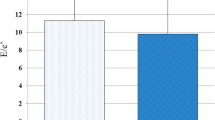Abstract
Diastolic dysfunction is associated with a high rate of morbidity and mortality and has a high prevalence in patients with diabetes. Aim of the study was to investigate the prevalence of diastolic dysfunction in patients with newly detected glucose metabolism disorder (GMD) submitted for coronary angiography. Oral glucose tolerance test, echocardiography, and tissue Doppler imaging were performed in patients referred to coronary angiography. Prevalence of diastolic dysfunction was 97, 88, and 74% in the known diabetes, newly detected diabetes, and new diagnosed impaired glucose toleranc group, respectively. This is higher than previously reported. Severity of diastolic dysfunction was associated with higher 2-h plasma glucose levels and with new diagnosed diabetes. Screening patients with newly detected GMD for diastolic dysfunction may identify patients with double risk for cardiovascular morbidity and mortality and this group might be a target population to avoid development heart failure.

Similar content being viewed by others
Abbreviations
- BNP:
-
Brain natriuretic peptide
- CAD:
-
Coronary artery disease
- DD:
-
Diastolic dysfunction
- EF:
-
Ejection fraction
- ESC:
-
European Society of Cardiology
- GMD:
-
Glucose metabolism disorder
- IGT:
-
Impaired glucose tolerance
- NT-ProBNP:
-
n-terminales-pro-brain natriuretic peptide
References
Bhatia RS, Tu JV, Lee DS et al (2006) Outcome of heart failure with preserved ejection fraction in a population-based study. N Engl J Med 355(3):260–269
Poirier P, Bogaty P, Garneau C, Marois L, Dumesnil JG (2001) Diastolic dysfunction in normotensive men with well-controlled type 2 diabetes: importance of maneuvers in echocardiographic screening for preclinical diabetic cardiomyopathy. Diabetes Care 24(1):5–10
Lankisch M, Futh R, Schotes D et al (2006) High prevalence of undiagnosed impaired glucose regulation and diabetes mellitus in patients scheduled for an elective coronary angiography. Clin Res Cardiol 95(2):80–87
Paulus WJ, Tschope C, Sanderson JE et al (2007) How to diagnose diastolic heart failure: a consensus statement on the diagnosis of heart failure with normal left ventricular ejection fraction by the Heart Failure and Echocardiography Associations of the European Society of Cardiology. Eur Heart J 28(20):2539–2550
Boyer JK, Thanigaraj S, Schechtman KB, Perez JE (2004) Prevalence of ventricular diastolic dysfunction in asymptomatic, normotensive patients with diabetes mellitus. Am J Cardiol 93(7):870–875
Bajraktari G, Koltai MS, Ademaj F et al (2006) Relationship between insulin resistance and left ventricular diastolic dysfunction in patients with impaired glucose tolerance and type 2 diabetes. Int J Cardiol 110(2):206–211
Bartnik M, Malmberg K, Norhammar A, Tenerz A, Ohrvik J, Ryden L (2004) Newly detected abnormal glucose tolerance: an important predictor of long-term outcome after myocardial infarction. Eur Heart J 25(22):1990–1997
Yu CM, Lin H, Yang H, Kong SL, Zhang Q, Lee SW (2002) Progression of systolic abnormalities in patients with “isolated” diastolic heart failure and diastolic dysfunction. Circulation 105(10):1195–1201
von Bibra H, Siegmund T, Hansen A, Jensen J, Schumm-Draeger PM (2007) Augmentation of myocardial function by improved glycemic control in patients with type 2 diabetes mellitus. Dtsch Med Wochenschr 132(14):729–734
Author information
Authors and Affiliations
Corresponding author
Additional information
R. Füth and W. Dinh have equally contributed to this study.
Rights and permissions
About this article
Cite this article
Füth, R., Dinh, W., Bansemir, L. et al. Newly detected glucose disturbance is associated with a high prevalence of diastolic dysfunction: double risk for the development of heart failure?. Acta Diabetol 46, 335–338 (2009). https://doi.org/10.1007/s00592-009-0105-8
Received:
Accepted:
Published:
Issue Date:
DOI: https://doi.org/10.1007/s00592-009-0105-8




